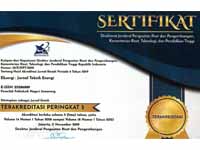PERBANDINGAN BEBERAPA PARAMETER OPERASI MESIN MOBIL INJEKSI TERHADAP PENGGUNAAN BAHAN BAKAR BENSIN DAN CAMPURAN METANOL-BENSIN M15
DOI:
https://doi.org/10.32497/eksergi.v12i3.617Abstract
M15 merupakan campuran metanol ( CH30H ) ”“ bensin dengan ratio 15:85. Keunggulan metanol adalah mempunyai angka oktan yang lebih tinggi dari pada bensin yaitu 109, kemudian metanol memiliki kandungan oksigen yang tinggi hingga 50% [1]. Pada penelitian ini bahan bakar ditambah dengan zat aditif 1,2-Propylene Glycol sebanyak 7mL per liter bahan bakar. Kemudian pada injektor bensin mesin mobil dipasang Metanol Injection Controller. Proses pengujian dilakukan pada posisi gigi ke-3 transmisi mobil. Proses pengambilan data parameter operasi mesin menggunakan Engine Scanner Auterra Dashdyno, parameter yang diambil adalah kecepatan mobil, air flow rate, fuel rate, air fuel ratio, ignition time advance, absolute throtlle position, dan instant economy. Pada beberapa grafik didapat berbagai fenomena yang terjadi, khususnya terdapat daerah efisiensi bahan bakar yang rendah. Hasil perbandingan nilai beberapa parameter yang diuji antara M15 dan bensin nilainya hampir sama khususnya pada kondisi idlehingga kecepatan dibawah 5000 rpm pada posisi gigi 3.
Keywords:Methanol; M15;Operation Parameters;Fuel Injection Car
Downloads
Published
Issue
Section
License
Authors who publish with this journal agree to the following terms:Authors retain copyright and grant the journal right of first publication with the work simultaneously licensed under a Creative Commons Attribution License that allows others to share the work with an acknowledgement of the work's authorship and initial publication in this journal.
Authors are able to enter into separate, additional contractual arrangements for the non-exclusive distribution of the journal's published version of the work (e.g., post it to an institutional repository or publish it in a book), with an acknowledgement of its initial publication in this journal.
Authors are permitted and encouraged to post their work online (e.g., in institutional repositories or on their website) prior to and during the submission process, as it can lead to productive exchanges, as well as earlier and greater citation of published work (See The Effect of Open Access).






